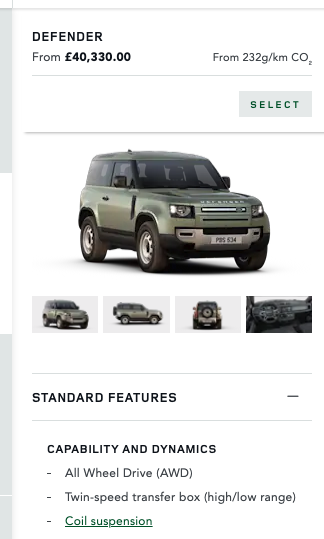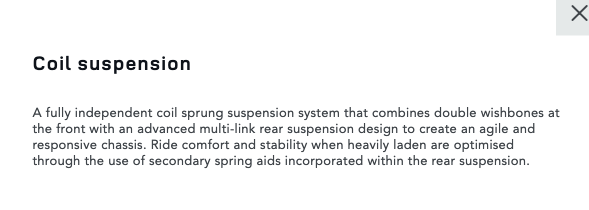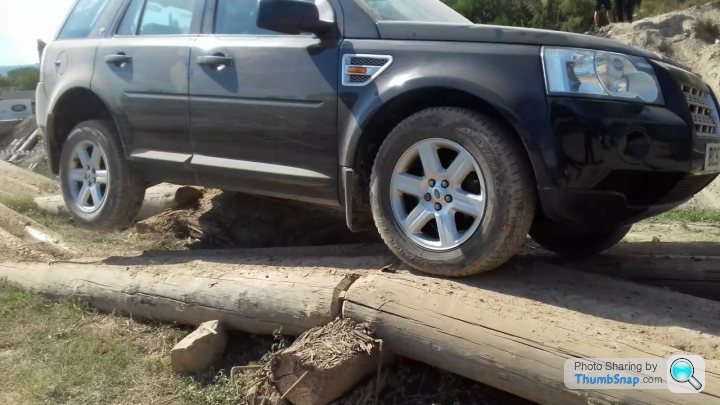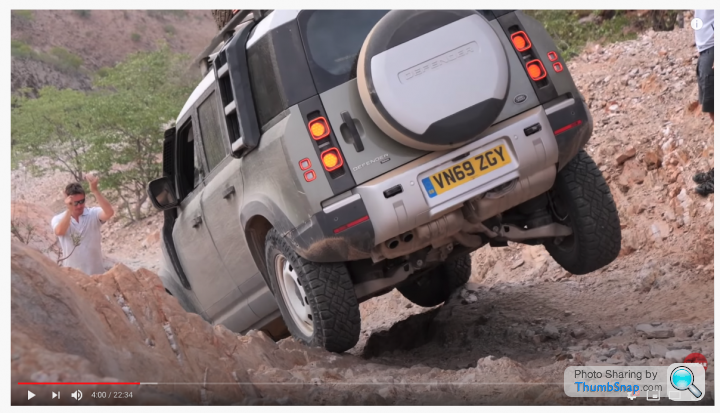Question for 'Max_Torque' - re: Defender suspension
Discussion
Hi Max, genuine question and interest. And thought you would be a good person to ask. Also didn't want to spam the existing Hardtop thread with this.
Looking at the Land Rover site at the new 90. I see there is a big jump in price between the models. However the base model states "coil suspension"


In the other thread you mention about the Gaydon proving ground and cited the RR:

The RR uses Land Rover's superb cross linked air suspension (for the benefit of other readers, when one wheel gets pushed up, air is transferred to the opposite wheel to push it down via the air springs. To simulate some of the movement of a live axle when off road).
With the base model Defender 90 lacking the air suspension and then the ability to simulate the movements of a live axle off road. What sort of impact do you think this will have vs the models that do have the air suspension - for off road use? And specifically like obstacles you cited in the above Range Rover image above and other technical off road driving.
I know in the case of the 3rd & 4th Gen Mitsubishi Shoguns, the all independent setup on coil springs heavily compromised their off road ability vs earlier models. There is also some evidence of this with the base spec Discovery 3, which also came with coils. And other Land Rover products (Freelander through to Evoque) that all use coil independent suspension. And while they are capable for their sector, they are often unpleasant to off road due to the inability to keep wheels on the ground (fine for going over fields, meaning more specific technical off roading).
Thanks.
Looking at the Land Rover site at the new 90. I see there is a big jump in price between the models. However the base model states "coil suspension"


In the other thread you mention about the Gaydon proving ground and cited the RR:

The RR uses Land Rover's superb cross linked air suspension (for the benefit of other readers, when one wheel gets pushed up, air is transferred to the opposite wheel to push it down via the air springs. To simulate some of the movement of a live axle when off road).
With the base model Defender 90 lacking the air suspension and then the ability to simulate the movements of a live axle off road. What sort of impact do you think this will have vs the models that do have the air suspension - for off road use? And specifically like obstacles you cited in the above Range Rover image above and other technical off road driving.
I know in the case of the 3rd & 4th Gen Mitsubishi Shoguns, the all independent setup on coil springs heavily compromised their off road ability vs earlier models. There is also some evidence of this with the base spec Discovery 3, which also came with coils. And other Land Rover products (Freelander through to Evoque) that all use coil independent suspension. And while they are capable for their sector, they are often unpleasant to off road due to the inability to keep wheels on the ground (fine for going over fields, meaning more specific technical off roading).
Thanks.
An interesting question.
I reckon it will make absolutely zero difference to anyone buying the car with coil suspension.
This is based on the fact that 99.999999% of people will buy it purely because they like it, and care not that it won't be able to climb the north face of the Eiger.
Further, I reckon the aforementioned 99.999999% will never use it off road, at all. The coil suspension has likely been engineered to tackle a speed hump, not wade through a metre of effluent whilst being clapped by a crowd.
Hopefully, the engineers know what they are doing, and have created a vehicle desirable to the 99.999999%, with a proper turning circle, a comfortable ride, a driving position that doesn't cripple you within an hour and with a bit of luck, not worrying too much about the 3 sales they will lose from people claiming 'its not a proper defender', who were massively unlikely to buy one anyway, and prefer to clog up internet forums with bizzarre arguments about the definition of 'off roading'.
I reckon it will make absolutely zero difference to anyone buying the car with coil suspension.
This is based on the fact that 99.999999% of people will buy it purely because they like it, and care not that it won't be able to climb the north face of the Eiger.
Further, I reckon the aforementioned 99.999999% will never use it off road, at all. The coil suspension has likely been engineered to tackle a speed hump, not wade through a metre of effluent whilst being clapped by a crowd.
Hopefully, the engineers know what they are doing, and have created a vehicle desirable to the 99.999999%, with a proper turning circle, a comfortable ride, a driving position that doesn't cripple you within an hour and with a bit of luck, not worrying too much about the 3 sales they will lose from people claiming 'its not a proper defender', who were massively unlikely to buy one anyway, and prefer to clog up internet forums with bizzarre arguments about the definition of 'off roading'.
braddo said:
The last words of the OP’s post:
“specific technical off roading”
No-one - absolutely no-one - uses a new unmodified car for this tiny niche of driving. Not a Defender pre-2016, and not a Defender today.
It is an utterly irrelevant question.
Well they do. The fact you personally don't see it happening, simply does not make it true. And is somewhat a rather narrow minded view if I'm being honest.“specific technical off roading”
No-one - absolutely no-one - uses a new unmodified car for this tiny niche of driving. Not a Defender pre-2016, and not a Defender today.
It is an utterly irrelevant question.
braddo said:
The last words of the OP’s post:
“specific technical off roading”
No-one - absolutely no-one - uses a new unmodified car for this tiny niche of driving. Not a Defender pre-2016, and not a Defender today.
It is an utterly irrelevant question.
It's ALMOST as though any answer, any answer whatsoever, will be responded with a week's worth of argument and counter argument about how the old defender, the greatest family car ever devised, would run rings around the new one, due to its suspension layout, how the new one isn't really a defender at all... And how the bog dwellers won't buy one as it simply doesn't work under 2 feet of turds*“specific technical off roading”
No-one - absolutely no-one - uses a new unmodified car for this tiny niche of driving. Not a Defender pre-2016, and not a Defender today.
It is an utterly irrelevant question.
- exactly as you state, absolutely no-one - uses a new unmodified car for this tiny niche of driving.
300bhp/ton said:
Well they do. The fact you personally don't see it happening, simply does not make it true. And is somewhat a rather narrow minded view if I'm being honest.
I'm interested in this. Can you link a YouTube video of the scenario/type of driving you have in mind. It'll make it a bit clearer for everyone.Even if the base model isn't as good off road, there's lots of cars where the base model lacks large amounts of capability compared to the higher range variants.
This isn't seen as unusual with road and track performance, so why is it unusual for off road performance?
Maybe it's our assumption that the cheap one is for off road work and it's the expensive ones that are more road biased which is wrong, and it should be the other way round. Paying more for an off-roader gets you a better off-roader.
This isn't seen as unusual with road and track performance, so why is it unusual for off road performance?
Maybe it's our assumption that the cheap one is for off road work and it's the expensive ones that are more road biased which is wrong, and it should be the other way round. Paying more for an off-roader gets you a better off-roader.
To be fair, when I had a new Defender in 2016, I did take it greenlaning and offroading in the snow etc., just for fun.
Having said that, it was not particularly good at it, and a Disco 5 was significantly better at off-roading. Not because of the suspension, but because the turning circle on the 110 meant that the only thing it could "run rings round" is a combine harvester. Having to do a 7 point turn just to be able to turn into a gate or track off the main one quickly turns into an Austin Powers sketch.
Hopefully the new Defender has fixed that little quirk
Coils will limit off-road ability on the new Defender, same as it does on a Discovery. Mostly simply due to ground clearance rather than anything else. That's not to say the standard Defender won't be able to comfortably do what 99.5% of customers will want from its capabilities. But air suspension on that platform does give a significant increase in both ground clearance and articulation.
Having said that, it was not particularly good at it, and a Disco 5 was significantly better at off-roading. Not because of the suspension, but because the turning circle on the 110 meant that the only thing it could "run rings round" is a combine harvester. Having to do a 7 point turn just to be able to turn into a gate or track off the main one quickly turns into an Austin Powers sketch.
Hopefully the new Defender has fixed that little quirk

Coils will limit off-road ability on the new Defender, same as it does on a Discovery. Mostly simply due to ground clearance rather than anything else. That's not to say the standard Defender won't be able to comfortably do what 99.5% of customers will want from its capabilities. But air suspension on that platform does give a significant increase in both ground clearance and articulation.

I used to drive defenders till I went soft. I think the percentage of people even doing this with a new defender will be vanishingly small and irrelevant to sales. Anyone who wants really hardcore will wait for the grenadier to appear.
I'd still have a defender mind, but would need to sell a kidney first.
300bhp/ton said:
Well they do. The fact you personally don't see it happening, simply does not make it true. And is somewhat a rather narrow minded view if I'm being honest.
Care to give some real world examples? (i.e. not journalists thrashing them around an off road course at a launch party)You'll find the airbag equipped models have a smidge more articulation, it's predominantly a more premium ride quality, NVH and comfort features like access height when you open the doors, being able to select high or low ride height etc.
The airbags in theory should be better off road, as if the car detects it's required, it can add something like 50mm extra travel, this isn't selectable by the customer, I think the car has to be in the right off road mode which may even be limited to low-range rock crawl.
I think it's mainly to offer a cheaper entry level model, some people won't want airbags either.
I imagine, but don't know for sure, that they're both validated off road by Land Rover to the same standard. Whether if you bought two and drove them beyond that standard, either would be better, I'm not sure.
The airbags in theory should be better off road, as if the car detects it's required, it can add something like 50mm extra travel, this isn't selectable by the customer, I think the car has to be in the right off road mode which may even be limited to low-range rock crawl.
I think it's mainly to offer a cheaper entry level model, some people won't want airbags either.
I imagine, but don't know for sure, that they're both validated off road by Land Rover to the same standard. Whether if you bought two and drove them beyond that standard, either would be better, I'm not sure.
SHutchinson said:
I'm interested in this. Can you link a YouTube video of the scenario/type of driving you have in mind. It'll make it a bit clearer for everyone.
Il use some Australian and US vids, as they show up the terrain better. And I admit less off roading of this nature is done in the UK. But there is still off roading here. Just usually more mud, less dust, more trees and less rocks.Please note these are all late model Land Rover's and at the time of filming, many of these would be new, privately owned vehicles.
Not sure where this is:
Or even the Defender launch material in S. Africa.
e.g. you can see the air suspension on this model:

Taken from this vid (vid not great and not worth watching all of): https://youtu.be/u5WN_oRSOqE
Curious how would the coil version compare. I'm assuming Land Rover may not have had any of the coil versions as part of the launch/promo stuff in S. Africa.
WestyCarl said:
I reckon you could drive 2 identical defenders, one coil, one air and the off road performance would be indistinguishable. (except maybe for comfort)
Both will be able to electronically brake any wheel not in contact with the ground rendering this argument pretty much academic.
Nope. When off road you know when a wheel isn't on the ground. And in order for the TCS to work, you need some wheel slip. A coil one, I'm assuming (hence the entire point of the thread). Will have the wheels off the ground a lot more and probably higher in the air.Both will be able to electronically brake any wheel not in contact with the ground rendering this argument pretty much academic.
Dusty964 said:
An interesting question.
I reckon it will make absolutely zero difference to anyone buying the car with coil suspension.
This is based on the fact that 99.999999% of people will buy it purely because they like it, and care not that it won't be able to climb the north face of the Eiger.
Further, I reckon the aforementioned 99.999999% will never use it off road, at all. The coil suspension has likely been engineered to tackle a speed hump, not wade through a metre of effluent whilst being clapped by a crowd.
Hopefully, the engineers know what they are doing, and have created a vehicle desirable to the 99.999999%, with a proper turning circle, a comfortable ride, a driving position that doesn't cripple you within an hour and with a bit of luck, not worrying too much about the 3 sales they will lose from people claiming 'its not a proper defender', who were massively unlikely to buy one anyway, and prefer to clog up internet forums with bizzarre arguments about the definition of 'off roading'.
I reckon it will make absolutely zero difference to anyone buying the car with coil suspension.
This is based on the fact that 99.999999% of people will buy it purely because they like it, and care not that it won't be able to climb the north face of the Eiger.
Further, I reckon the aforementioned 99.999999% will never use it off road, at all. The coil suspension has likely been engineered to tackle a speed hump, not wade through a metre of effluent whilst being clapped by a crowd.
Hopefully, the engineers know what they are doing, and have created a vehicle desirable to the 99.999999%, with a proper turning circle, a comfortable ride, a driving position that doesn't cripple you within an hour and with a bit of luck, not worrying too much about the 3 sales they will lose from people claiming 'its not a proper defender', who were massively unlikely to buy one anyway, and prefer to clog up internet forums with bizzarre arguments about the definition of 'off roading'.
Dusty964 said:
It's ALMOST as though any answer, any answer whatsoever, will be responded with a week's worth of argument and counter argument about how the old defender, the greatest family car ever devised, would run rings around the new one, due to its suspension layout, how the new one isn't really a defender at all... And how the bog dwellers won't buy one as it simply doesn't work under 2 feet of turds*
Sometimes you lot are a miserable bunch of cynical old men - exactly as you state, absolutely no-one - uses a new unmodified car for this tiny niche of driving.

Discussion is meant to be purely about the current model. Coil vs air. As is clearly asked in the Op.
Essel said:
I think the percentage of people even doing this with a new defender will be vanishingly small and irrelevant to sales. Anyone who wants really hardcore will wait for the grenadier to appear.
I'd still have a defender mind, but would need to sell a kidney first.
Where have I mention sales?? I'd still have a defender mind, but would need to sell a kidney first.

Max is an engineer, not a sales exec. I want to discussed the technical merits, not profit margins...
The crosslinking is effectively a roll stiffness reducer for higher articulations.
Like for like spring/ARB rates, the vehicle without the crosslink will have a higher roll stiffness at higher articulations so will put more load into the compressed side and might lift the unloaded wheel earlier into the travel on the other side.
However if Land Rover have chosen to go for softer spring rates on coils and compromise the on road handling to keep off road traction then it could easily be the same.
Like for like spring/ARB rates, the vehicle without the crosslink will have a higher roll stiffness at higher articulations so will put more load into the compressed side and might lift the unloaded wheel earlier into the travel on the other side.
However if Land Rover have chosen to go for softer spring rates on coils and compromise the on road handling to keep off road traction then it could easily be the same.
SuperPav said:
but because the turning circle on the 110 meant that the only thing it could "run rings round" is a combine harvester. Having to do a 7 point turn just to be able to turn into a gate or track off the main one quickly turns into an Austin Powers sketch.
Do you have the 110 still? Very easy to massively improve the turning circle, although it is a fairly long old bus. So will never turn on a sixpence.Factory steering stops will be preventing full lock. Also if you run a slightly wider offset rim or a spacer you can then wind the steering stops all the way in and get a lot more steering lock and a much smaller turning circle.
300bhp/ton said:
LimSlip said:
Care to give some real world examples? (i.e. not journalists thrashing them around an off road course at a launch party)
Done, see above.How did that compare to the previous model?
How does that compare to the converted coil spring cars?
Gassing Station | Land Rover | Top of Page | What's New | My Stuff



